A rare Atlantic Niña event is ongoing across the tropical Atlantic, with a growing influence on hurricane activity in the coming weeks. This unusual ocean anomaly can also signal large-scale changes in the global weather system, also bringing early clues about the upcoming Winter 2025/2026 across the United States, Canada, and Europe.
“This Article was updated on July 31, 2025 with fresh forecast and analysis data”
In this article, we will look at the latest ocean and atmospheric signals from the Atlantic and Pacific, their expected impact on the hurricane season, and also the long-term signal that they show for Winter 2025/2026 and the even Polar Vortex.
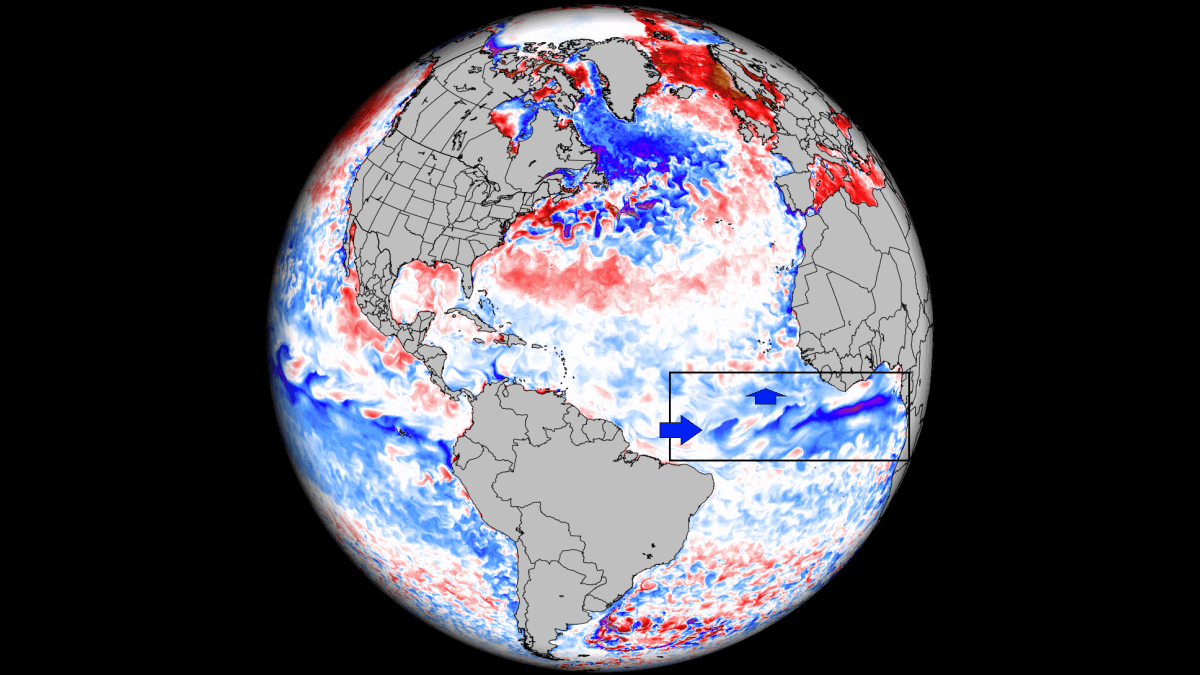
FROM OCEAN TO THE ATMOSPHERE
Ocean anomalies play an important role in the global weather system. The Atlantic temperature anomalies are known to have direct impacts on the hurricane season, while the influence of large Pacific anomalies like the La Niña and El Niño reaches far into the Winter and Spring seasons over the globe.
Below is the global ocean temperature map, where you can see some of the more important regions marked. In the Pacific, we have ENSO regions, where the well-known La Niña and El Niño events unfold. In the central Atlantic, you can see the area where their smaller and less common versions can develop, named Atlantic Niño/Niña.
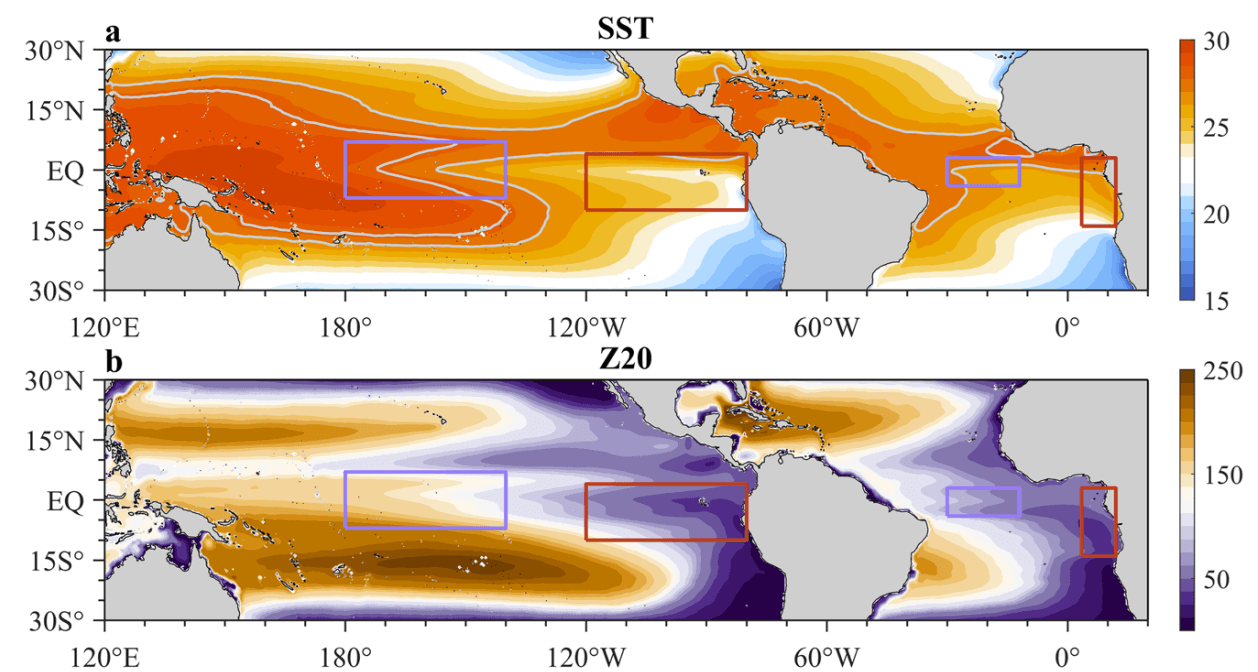
Looking first at the Atlantic area, you can see the main atmospheric influence it can have during the hurricane season and potential United States landfalls. In a warm Atlantic Niño, the number of tropical cyclones is almost twice as high as during a cold phase, and that includes landfalls in the United States.
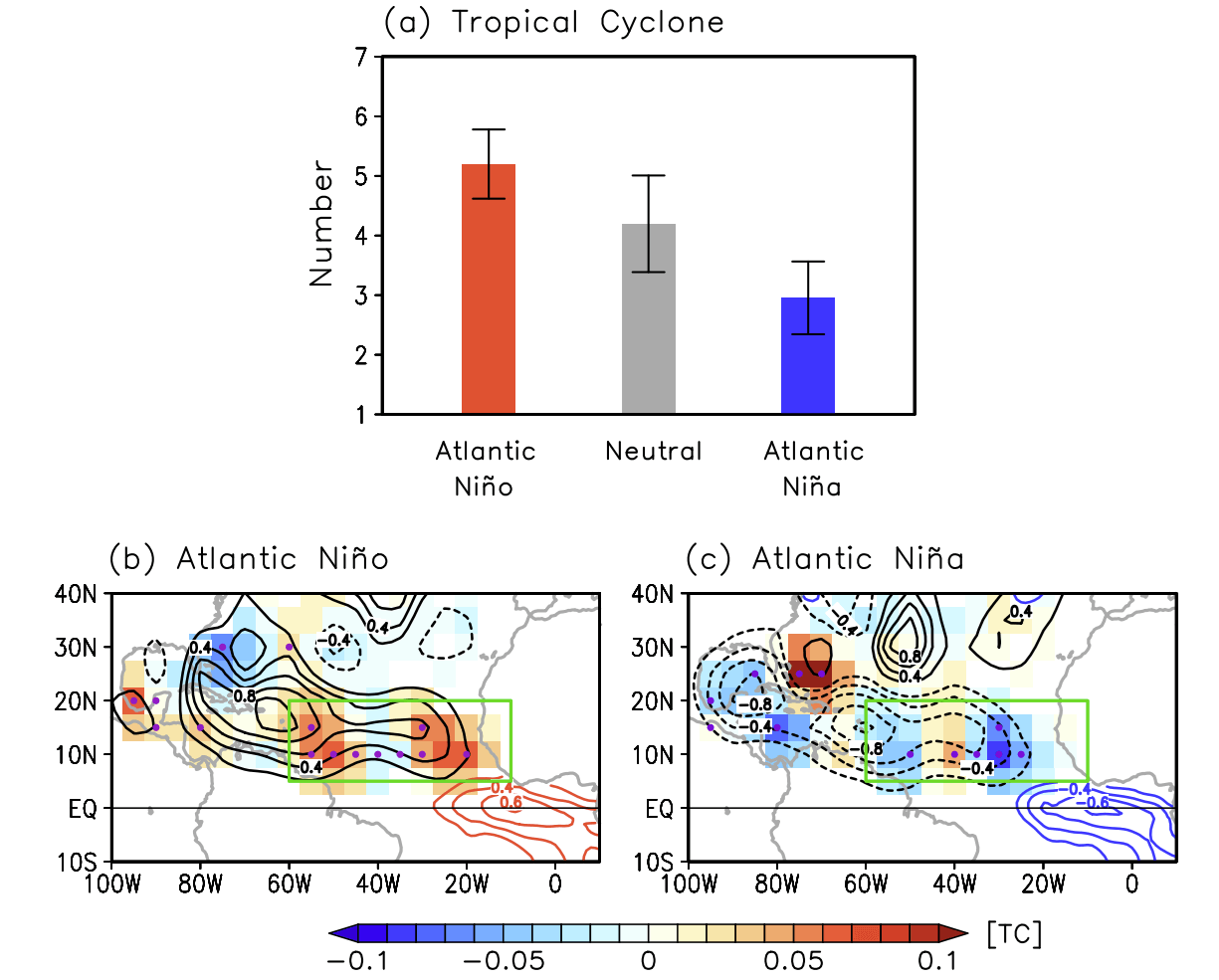
The reach of the Pacific ENSO anomaly is much greater. It also impacts the hurricane season, but its effects are strongest during the cold weather season. The image below shows jet stream redirection from La Niña, which is the cold ENSO phase, and the resulting Winter weather patterns developing over the United States and Canada.
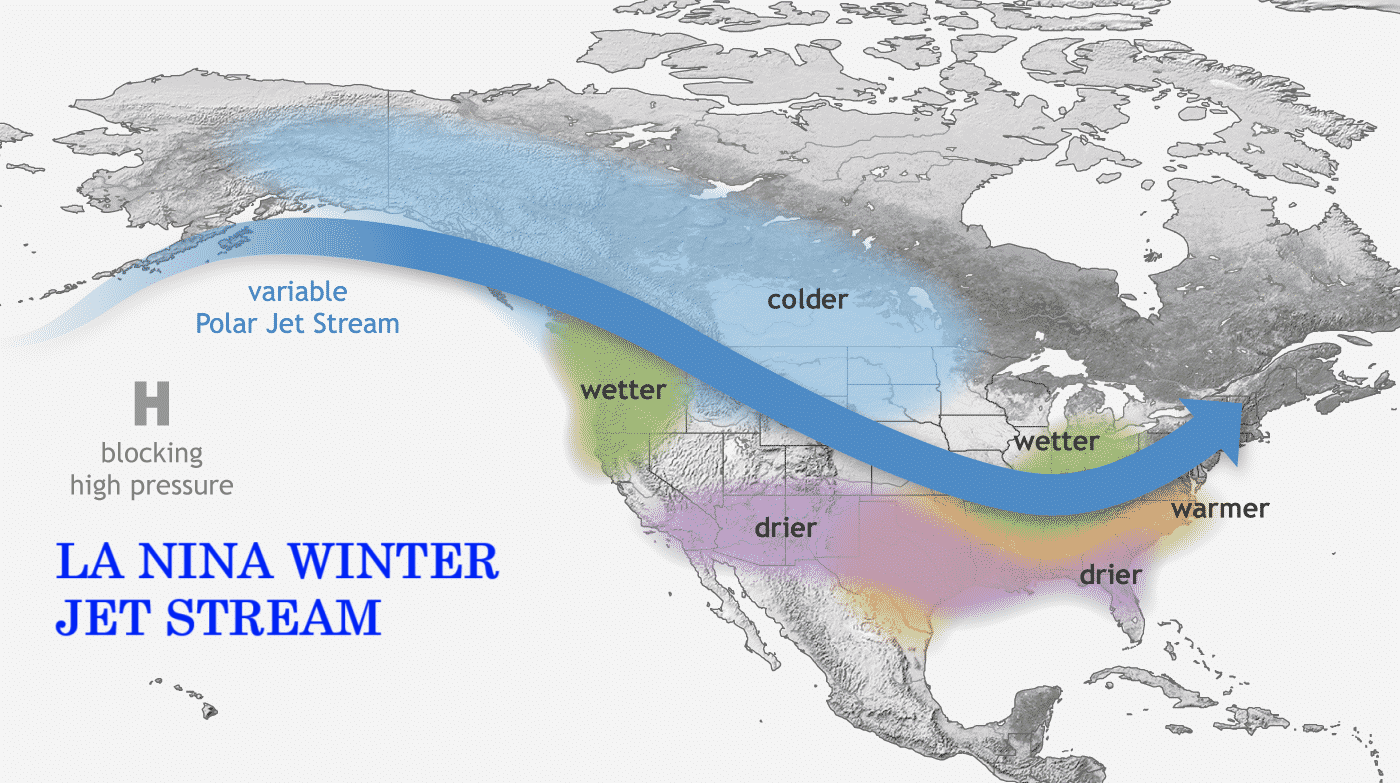
Looking ahead, you can see the ensemble forecasts below for the main ENSO region. The average forecast from all the calculations falls within the colder phase, with a high number of calculations well within a weak La Niña threshold. The weakest signal is from the ECMWF model, but it has made a step closer to a La Niña since the previous run.
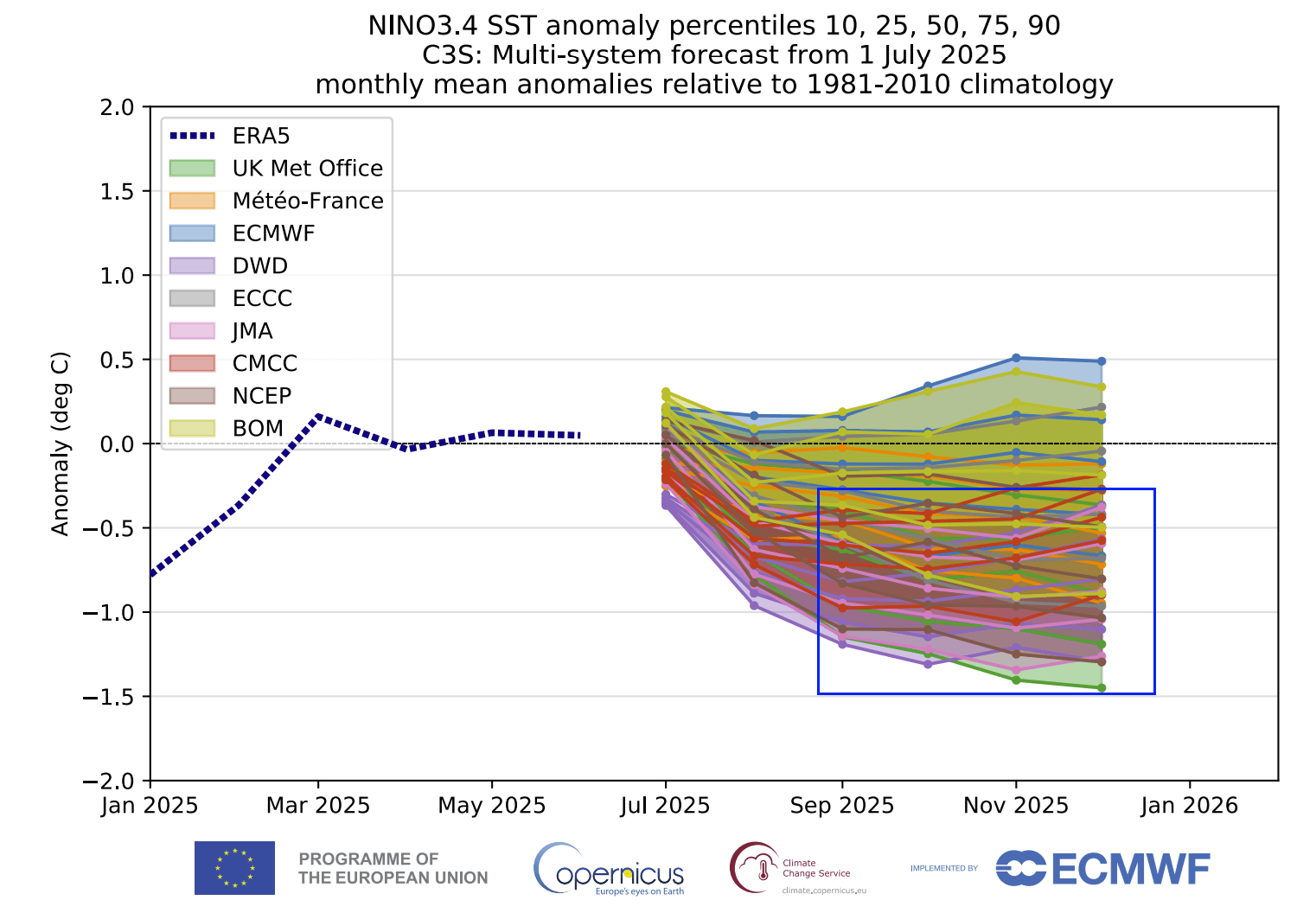
We showed you the La Niña impact on North America because a La Niña phase is currently forecast to develop for the 2025/2026 cold weather season. The forecasts show a rather weak event for now, which plays a big role in the type and strength of the weather outcomes that the La Niña can produce.
All these anomalies are driven by the trade winds, the prevailing easterly winds that circle the Earth near the equator. As they blow across the ocean, they typically cool the ocean’s surface by bringing the deeper, colder waters to the ocean’s surface (upwelling).
But weaker trade winds (or westerly winds) can mean the opposite, leaving calmer waters with less mixing, allowing the ocean temperatures to warm up. This means that the resulting ocean anomalies can be used as an “indicator”, of the state of the atmosphere, and what to expect from the global weather system.
A RARE EVENT ONGOING
Before looking at the latest ocean development, we must know what the term “anomaly” really is in weather, as it’s used very often. To keep it simple, it means a deviation from the long-term average.
When it comes to oceans or weather, a temperature anomaly means that the temperature is either higher or lower than it should be for that time of year. That can be significant, as it shows some large-scale changes in the global weather system.
The image below from NOAA CRW shows the updated ocean temperature anomaly analysis. You can nicely see the cold Atlantic Niña event. Over the Pacific, we have the ENSO regions, which are currently in a neutral phase, but a cooling has recently begun over the central area.
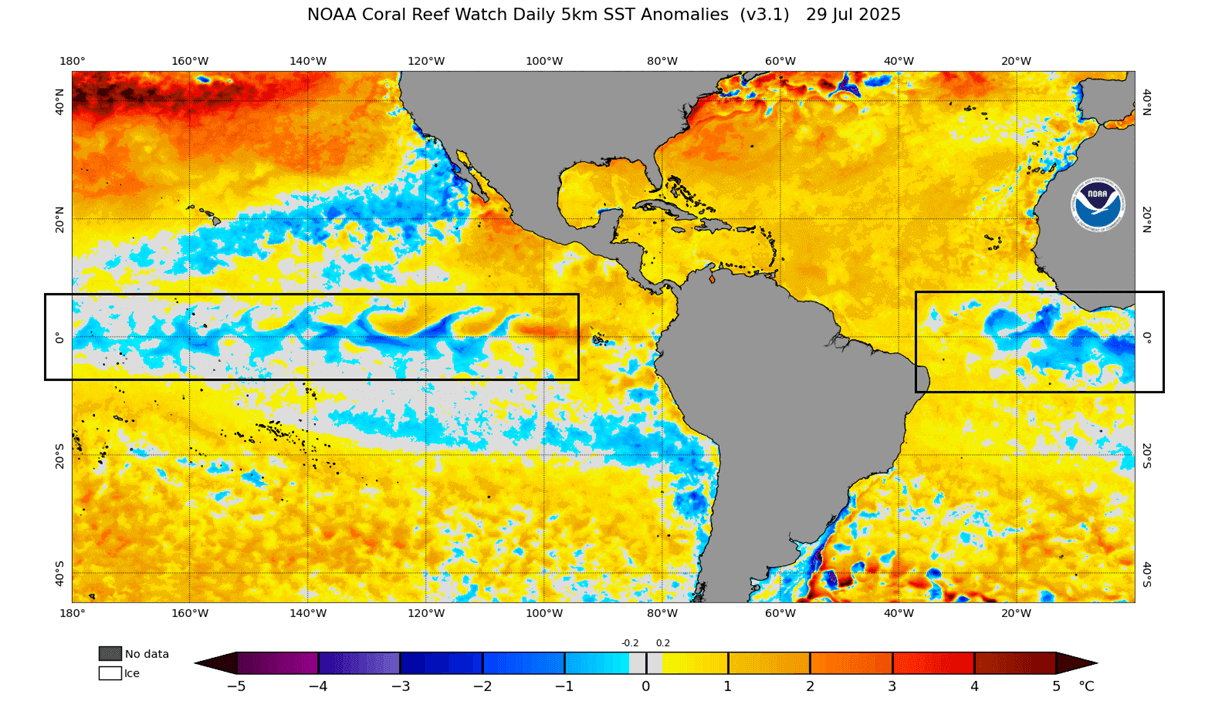
This indicates continued strong trade winds in the tropical Atlantic, which have implications for the hurricane season and the overall atmospheric conditions. The ENSO regions in the Pacific currently have less of an impact, but the long-range predictions do show a La Niña returning.
Below is a close-up analysis from the same dataset, which is among the highest quality ocean analyses. It shows a broad area of cold anomalies, consistent with an Atlantic Niña event. The temperatures in that region are 1-3 degrees C lower than normal, due to constant strong easterly trade winds.
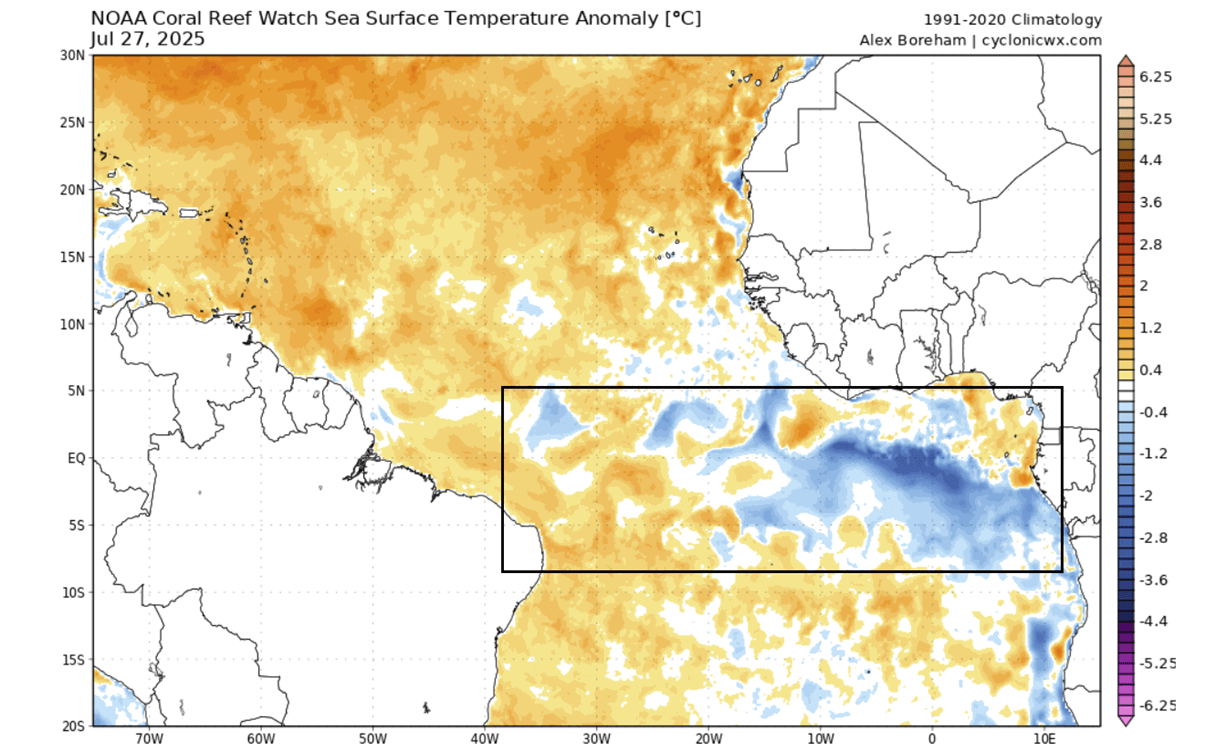
We can look at the 7-day anomaly change map below to see the weekly changes. You can see that cooling continues across the smaller eastern parts of the Atlantic Niña event, with a warmup present in the central parts, due to a westerly wind anomaly.
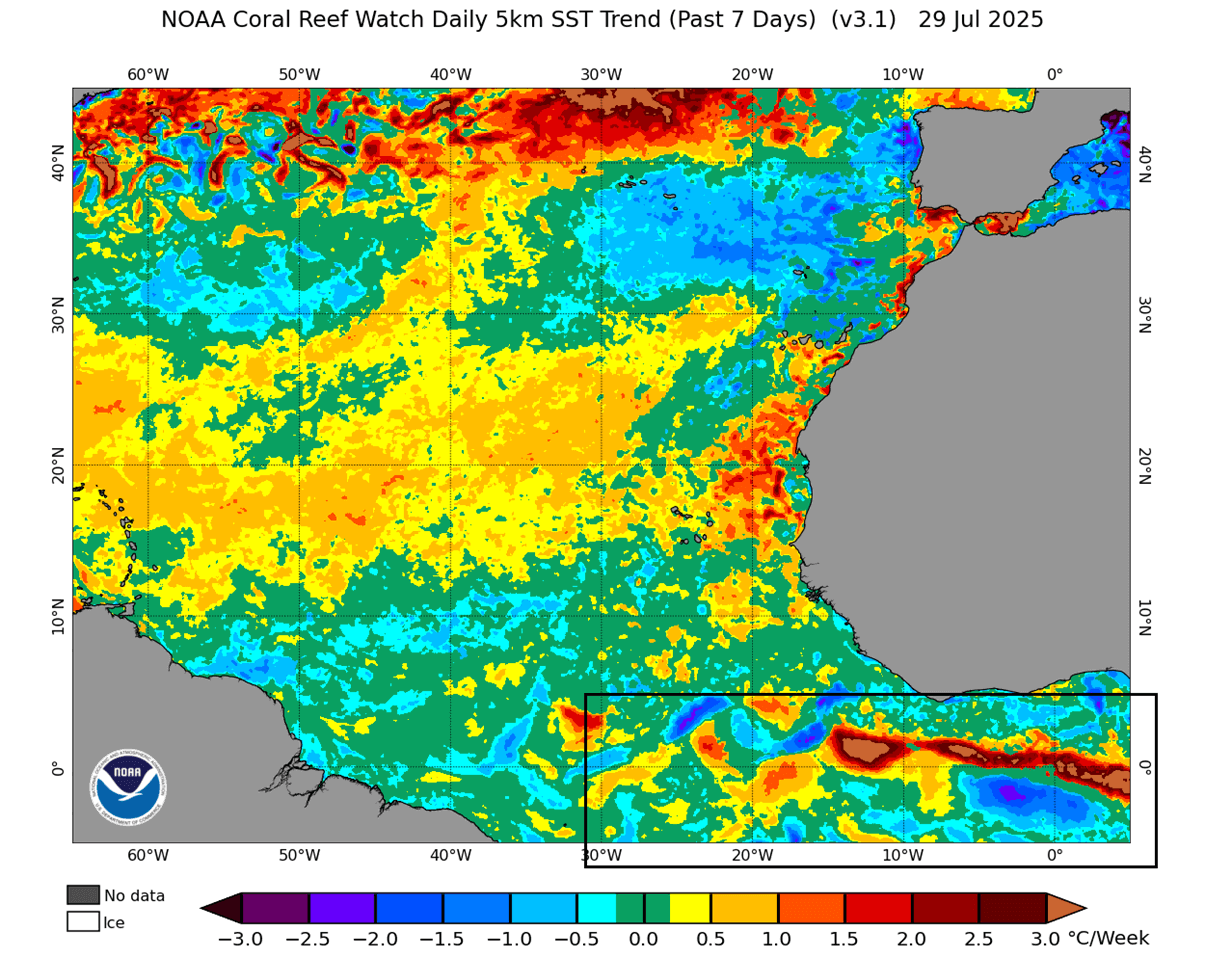
You can see the overall growth process of the Atlantic Niña in the video below, made from NOAA CRW analysis. It shows the rapid cooling in the tropics and the emergence of the Atlantic Niña event in the May/June period.
Such an event affects the weather patterns across a large area. But more importantly, it indicates broader changes in the atmosphere. So for that reason, we can use the long-term data and produce some maps that show the typical atmospheric changes during these events.
LARGE-SCALE WEATHER CHANGES
When observing changes in the atmosphere, there is usually one indicator that tells us right away how the atmospheric circulation is behaving. It’s the so-called “Velocity Potential”. This tells us on a large scale, where the air is sinking and where it is rising in the atmosphere.
You can see a typical such circulation in the image below: Increased storms and rainfall on one side and reduced storms and drier weather on the other side. You can see on the top, the air is diverging (moving away) over the wet phase and converging (moving together) over the dry phase. This horizontal movement of air is referred to as the Velocity Potential in the tropics.
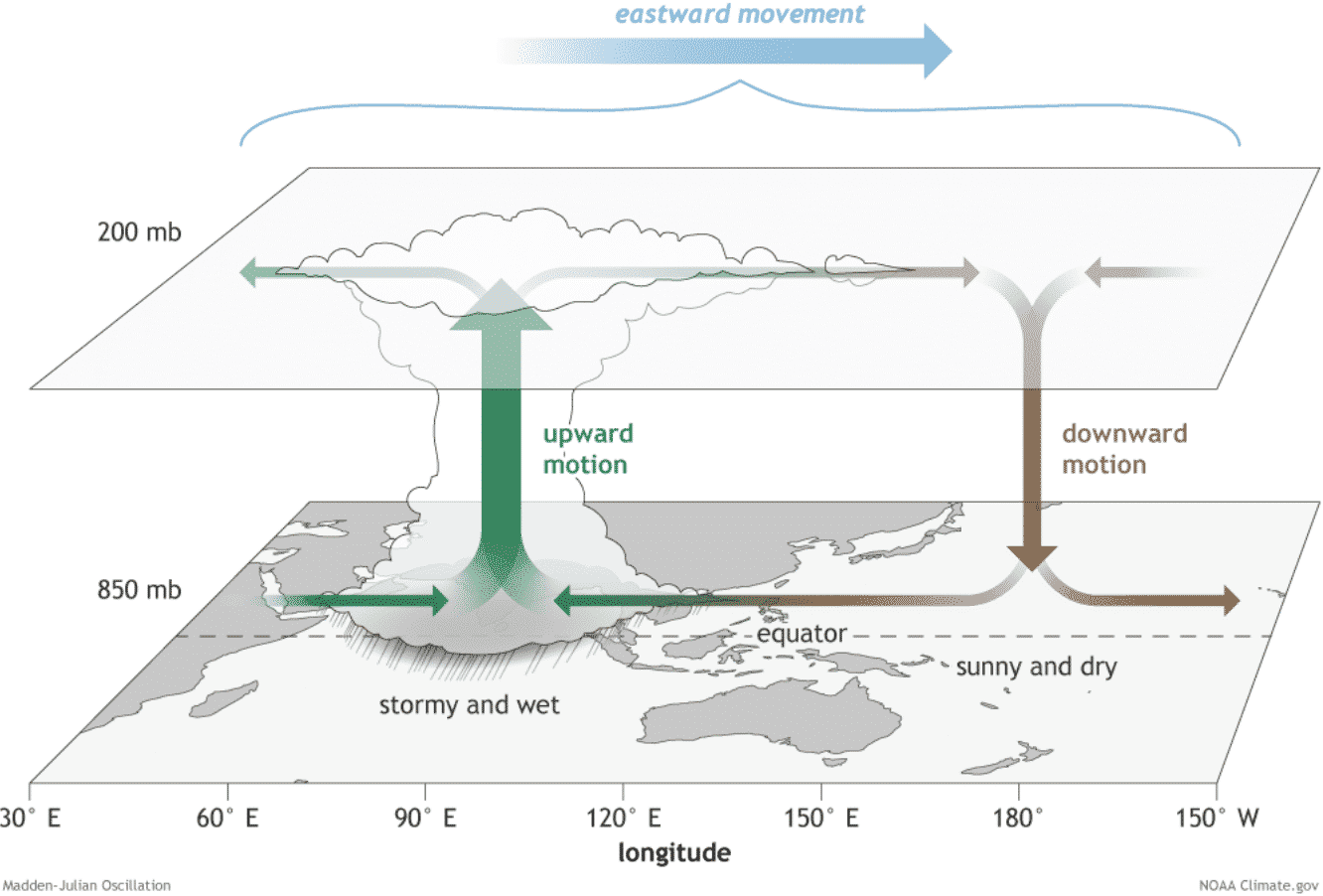
Sinking air means that the atmosphere is stable, so there are fewer clouds and tropical activity. This is usually found above large cold ocean anomalies. Rising motion means more clouds and rainfall, and increased tropical storm activity, and is typically associated with warmer ocean waters.
Below is the average upper-level velocity potential during a cold Atlantic Niña event in August. You can see a significant sinking of the air over the Atlantic, aided by the cold Niña event, or at least by its driving force.

The main focus in these maps is usually on the so-called Main Development Region (MDR). It got its name from the Hurricane season, and is seen roughly outlined in the next image below. It is where tropical systems form and strengthen during the Hurricane Season.
You can see the pressure trends during an active Atlantic Niña in the August-September period, based on over 4 decades of data. The higher pressure in the MDR indicates less tropical storm activity and a lower number of potential landfalling hurricanes in the United States. It also indicates worse atmospheric conditions for the tropical system to intensify in.
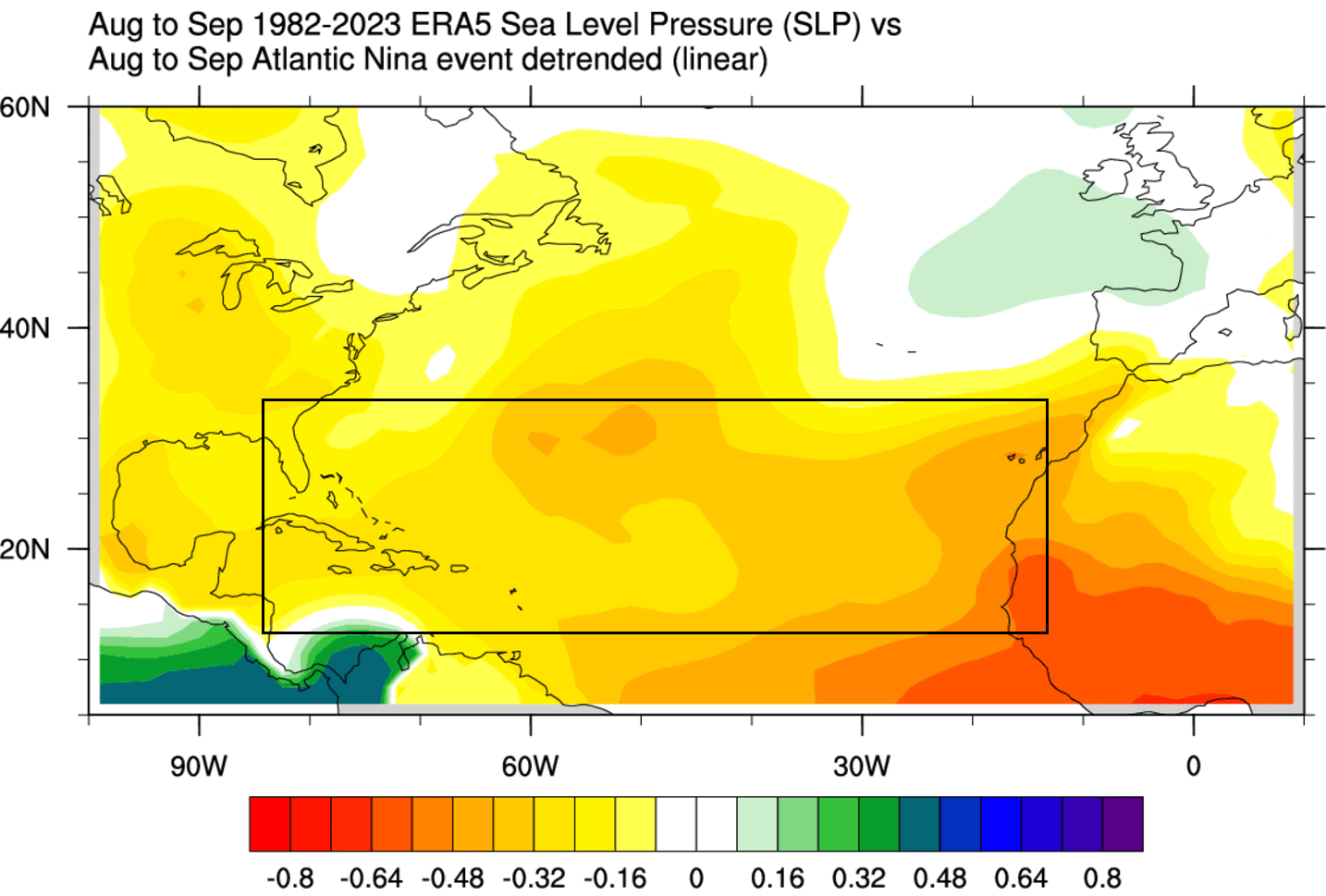
Looking at the precipitation trends, you can see a very similar scenario. There is less rainfall overall in the main development region. This indicates a reduced number of tropical systems and a lower number of landfalling systems in the United States. At least across the whole season, so individual systems can still have an impact in a quiet season.
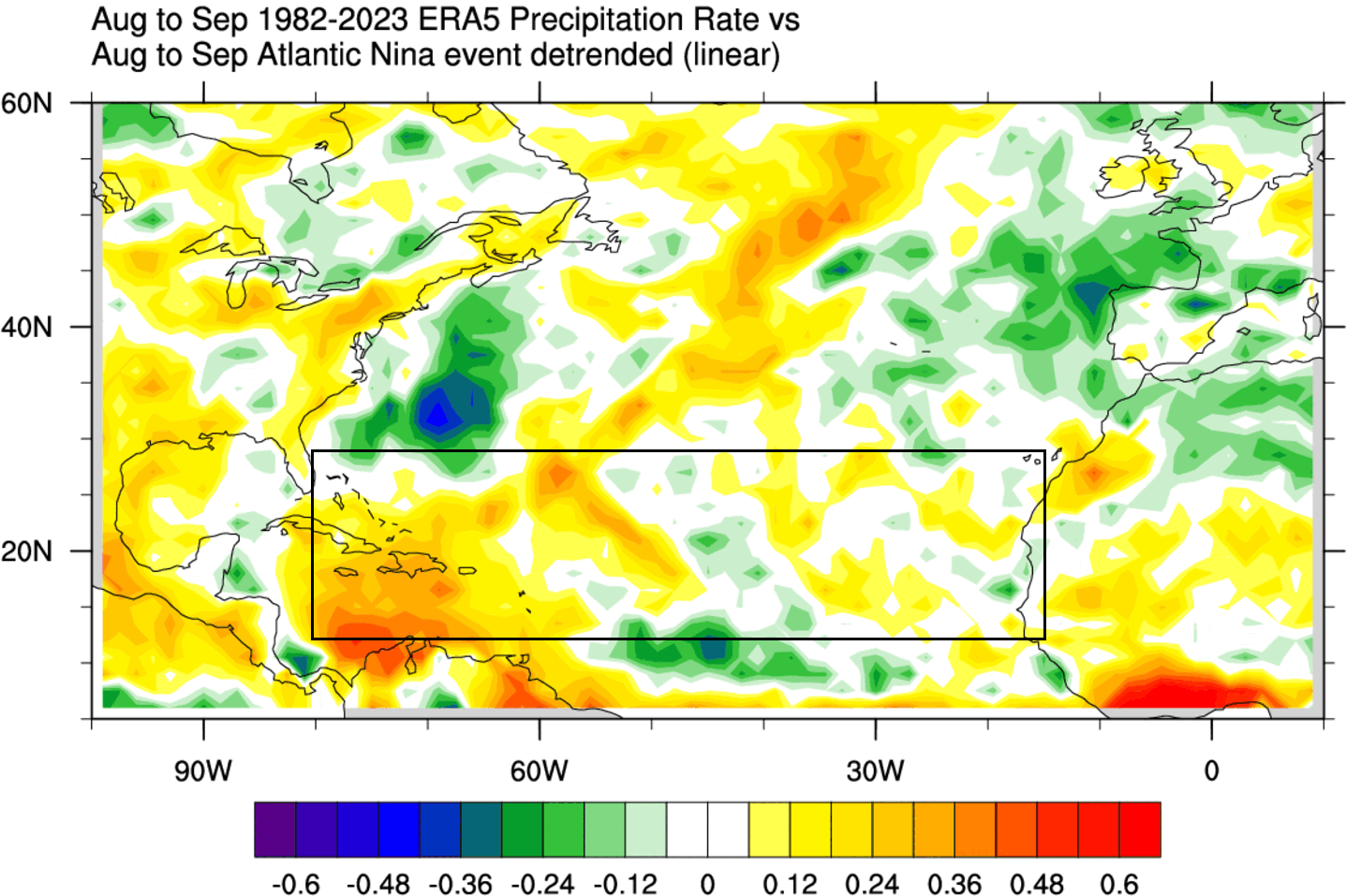
We can also look at the precipitable water analysis. Precipitable water is basically the total amount of water molecules (vapor/moisture) in a vertical column of the atmosphere that could be converted into rainfall or other precipitation like snowfall.
Below is the precipitable water analysis during an Atlantic Niña in the same period. You can see an overall drier atmosphere in the main development region, creating less favourable conditions for tropical systems to develop and intensify.
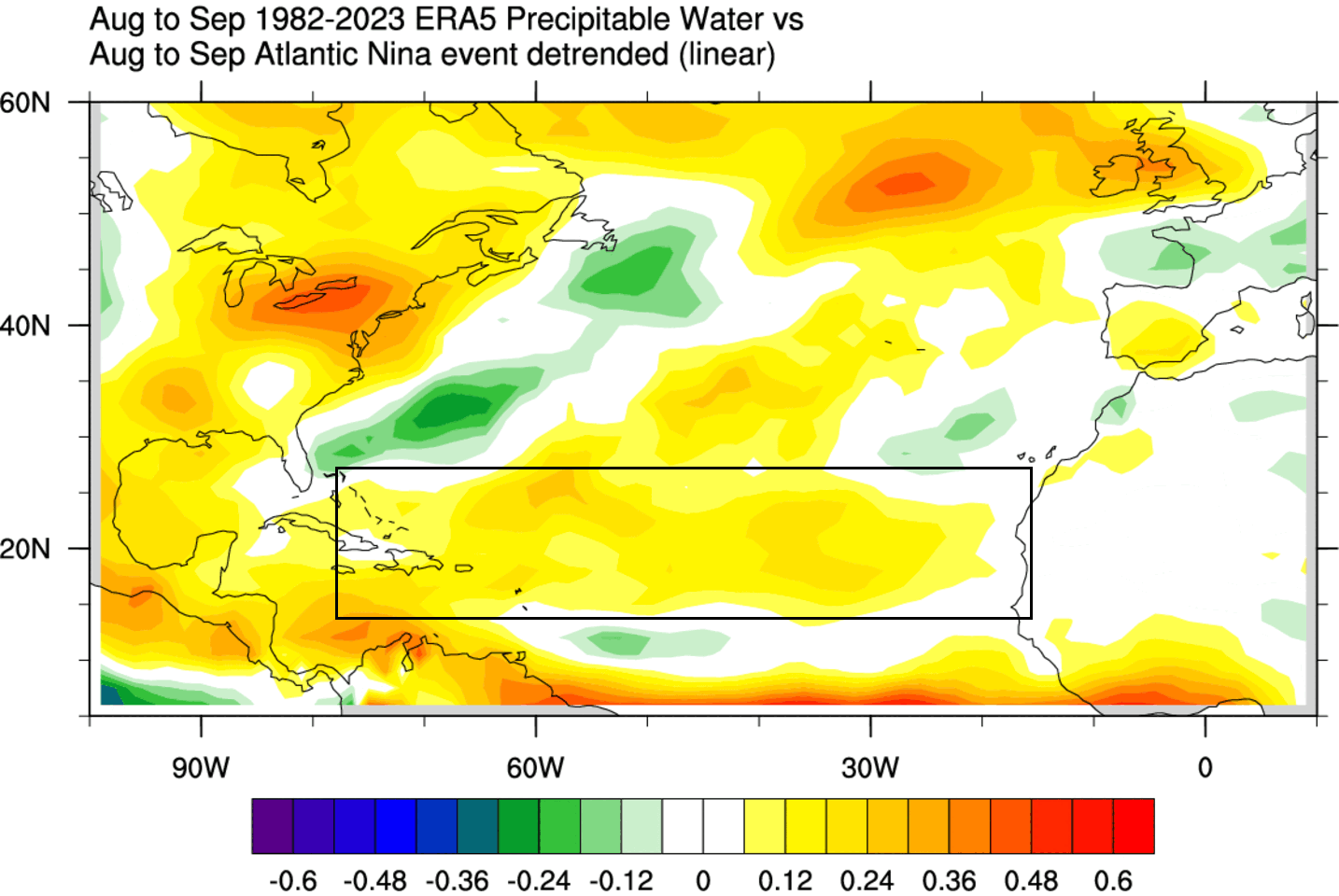
This is just a general analysis based on the available data, which shows that an Atlantic Niña usually comes with pretty unfavorable conditions for hurricanes. We can also look at the latest forecasts and see what they show for August in terms of tropical activity and atmospheric patterns.
UPDATED AUGUST ATLANTIC ACTIVITY FORECAST
Below is a velocity potential forecast from the ECMWF for mid-August. If you recall from the previous section, brown colors indicate sinking air in the atmosphere. This means that the atmosphere is suppressing convection and tropical systems in the MDR in the coming weeks. This is exactly what you would expect during an Atlantic Niña.
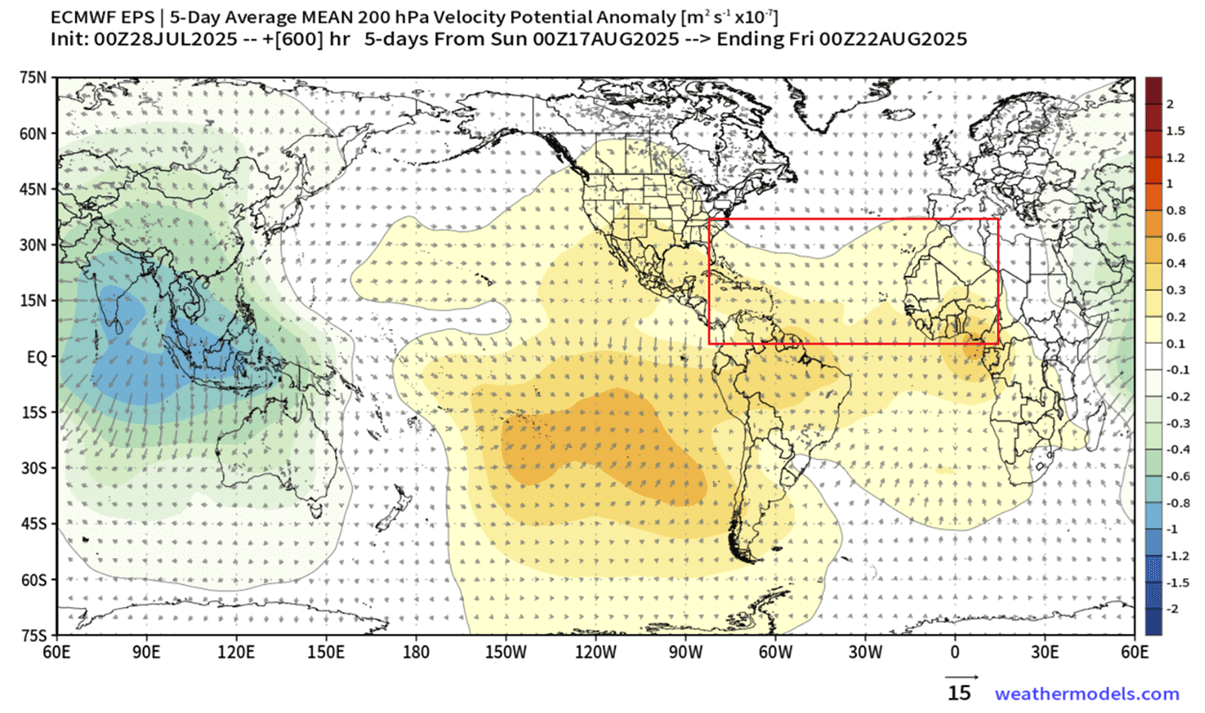
The next image shows the rainfall forecast for the whole of August, and is perhaps the most telling indicator you can use. This is the latest model run, and you can see an area of more rainfall in the Bermuda area and towards the eastern United States. Some of that could be from tropical systems that are more likely to develop closer to the United States.
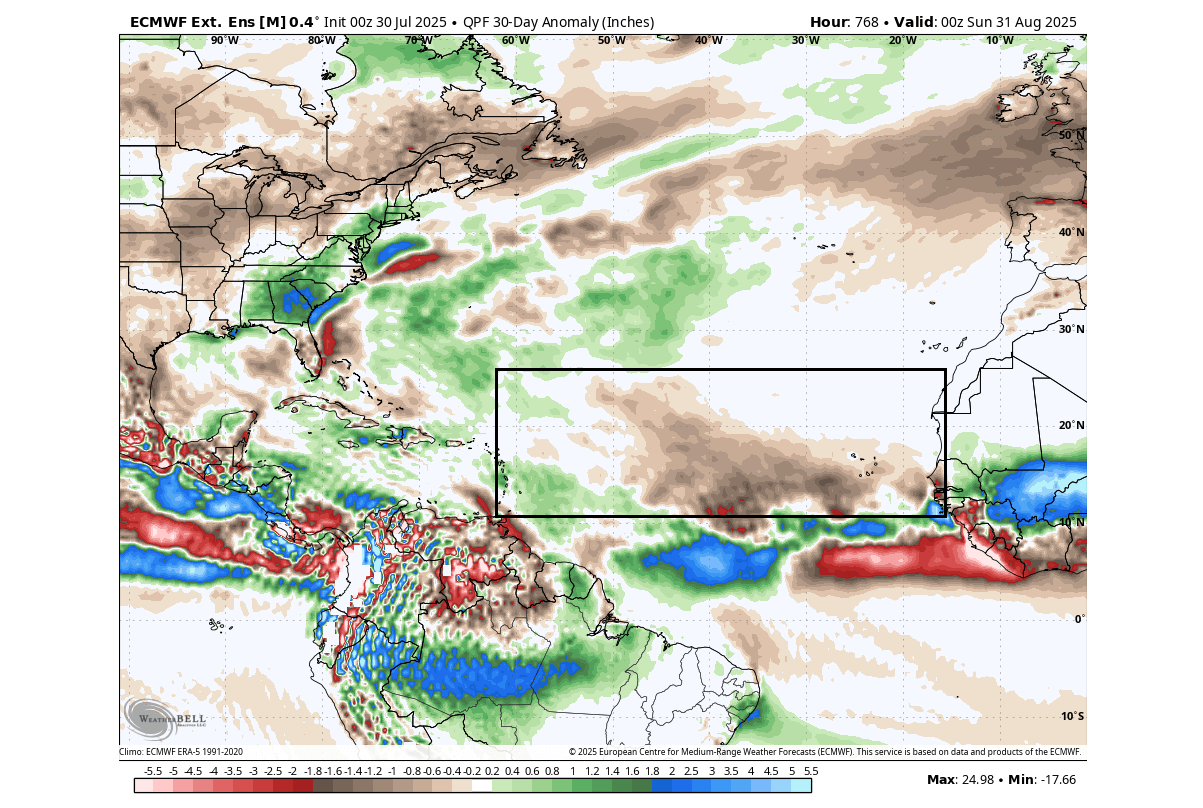
But you can see a broad area of below-normal rainfall over the main development region. This indicates suppressed convection and tropical activity, which greatly reduces hurricane potential, as expected during Atlantic Niña events.
You can still see increased rainfall in the Caribbean in this updated image, indicating more tropical potential closer to the United States instead of coming from further out. This indicates that despite a slower Atlantic area, the regions closer to the U.S. still require close monitoring.
Below, you can also see the surface pressure anomaly forecast for August, and you can see mostly above-normal pressure over the tropics and the MDR area. This area usually shows lower pressure in an active season, but August looks to remain less active in terms of potential hurricanes making landfall in the United States.
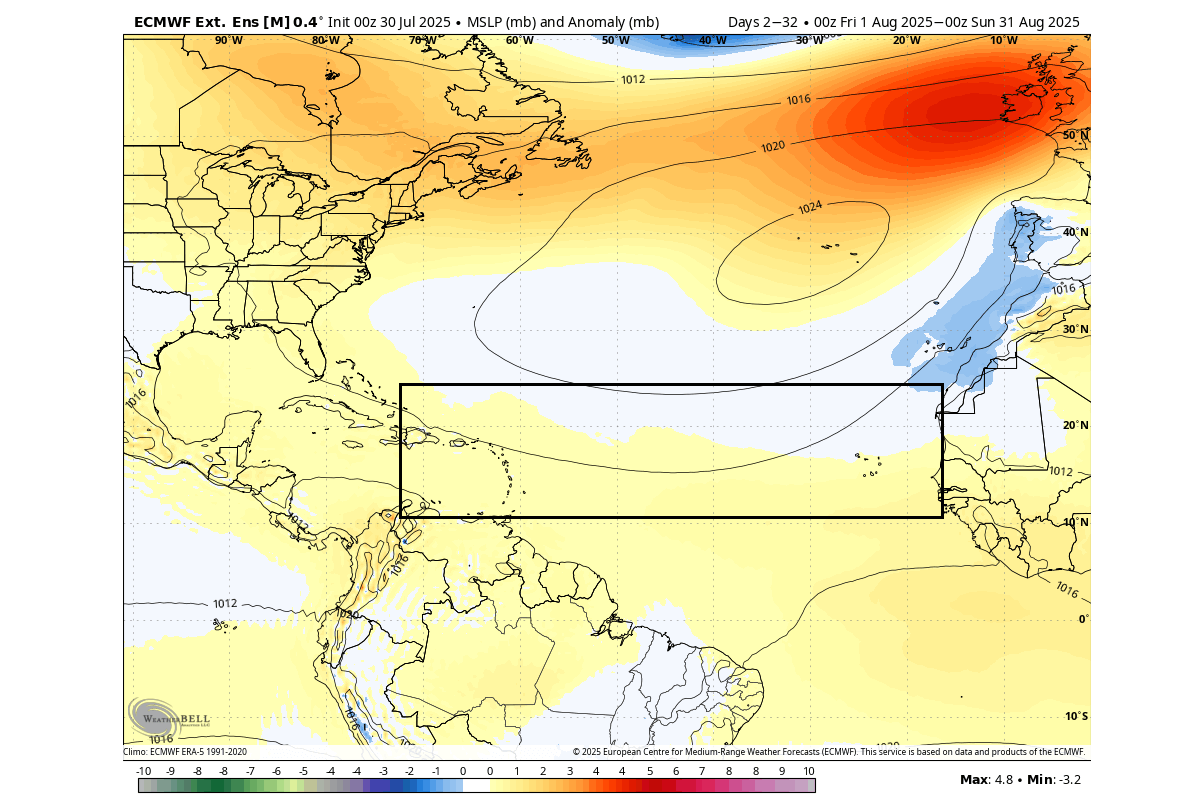
This updated pressure forecast does show less of a high-pressure anomaly than the previous run for August. This indicates a potential slow trend shift for a window of some tropical development for September and October, which are also the statistical peak of the Hurricane season.
Looking at the updated EPS ensemble forecast below, you can see individual cyclone locations from all its 51 members for the next 15 days. It actually shows some potential for tropical development towards mid-August, for a system or two coming from the tropical waves in the Atlantic region. The updated forecast does show a bit more potential than the older forecast.
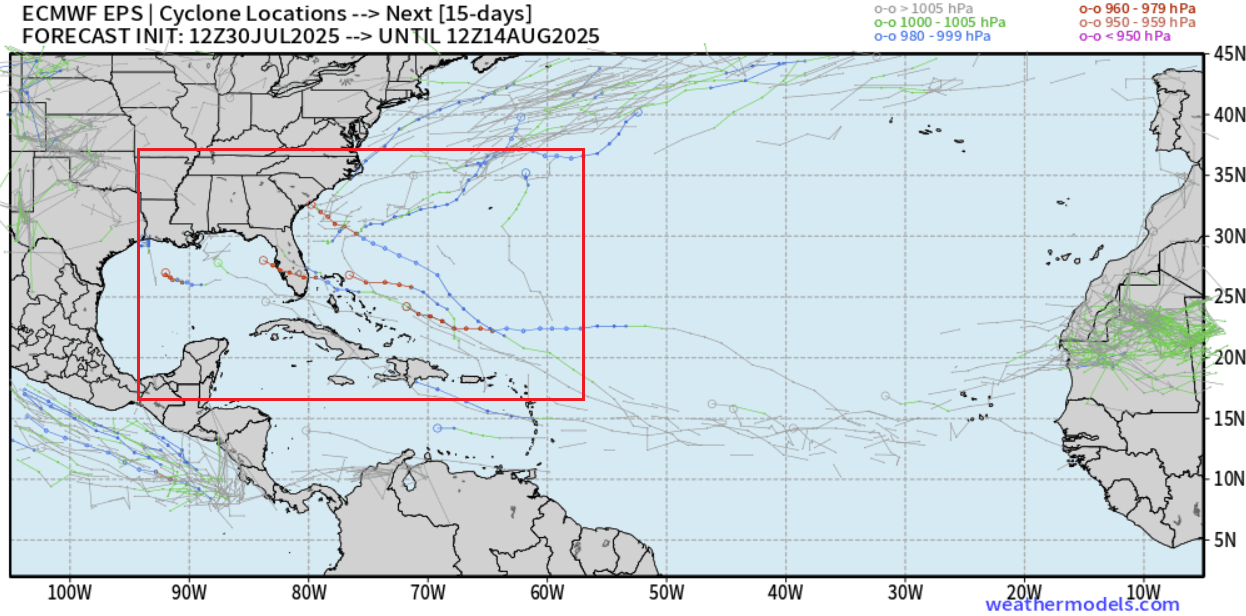
This is added as a reminder that even in a very quiet and suppressed hurricane season, you can still get some individual systems spinning up. There is never a zero-hurricane season, and only one landfall is enough to cause serious damage. So we must never let our guard fully down, despite an Atlantic Niña.
Looking ahead into early September, the updated velocity potential forecast shows continued sinking motion in the Atlantic, but starting to weaken and pull back to the southwest. You can also see an increased convective area and more rainfall over eastern tropical Africa.

This indicates a potential for a few more tropical systems to form in September, which is also the peak time of the hurricane season. But the total numbers are still expected to remain below average for the season, with reduced United States landfall potential.
To get a clearer picture, we added a new graphic in this update that shows the velocity potential for the whole forecast period. You can see the progression and movement of the atmospheric circulation “cells”. We have marked the Atlantic area, which does show subsidence and a less favorable tropical system environment overall.
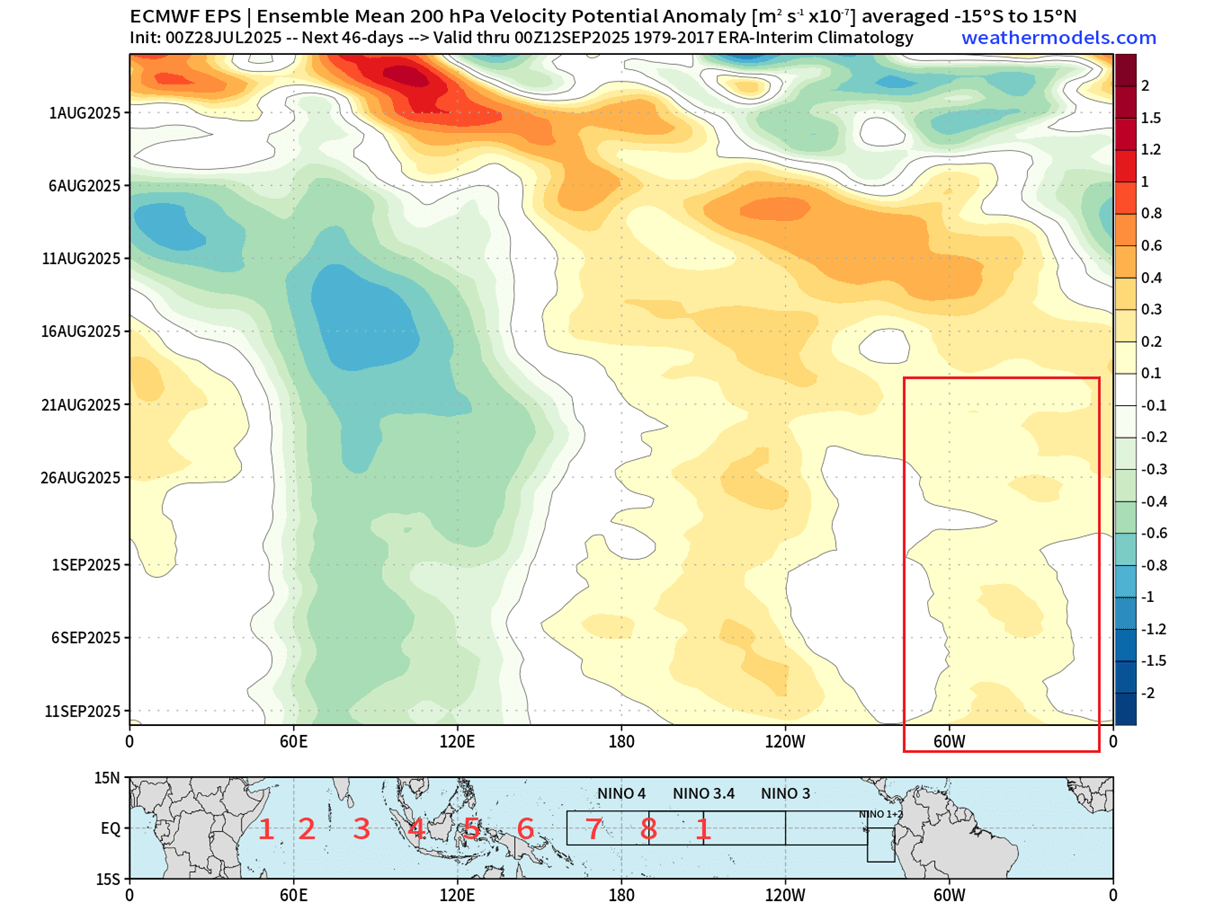
But a growing area of convection and storms is seen over the Indian Ocean, slowly extending into East Africa. This could at least increase the number of waves coming into the Atlantic, increasing the potential for activity during the peak Hurricane season.
Speaking of the peak season, we can look at the latest long-range predictions for the peak of the hurricane season and see if they show any Atlantic Niña influence.
A LARGE-SCALE SHIFT IN THE FORECAST
Before finding any Atlantic Niña signature, we of course have to look if it’s still going to be present. And for that, we decided to use the NMMM model data. The NMMM is a North American model blend that produces final predictions from various long-range models from the United States and Canada. This gives it a nice variety in the data before making the final image.
Below you can see the ocean forecast for the August-October period. It’s a probability forecast, and it does indicate colder ocean waters in the equatorial Atlantic region. It covers a 3-month period, so the overall Atlantic Niña signal will get weaker into September and October, but it’s still present in the 3-month average.
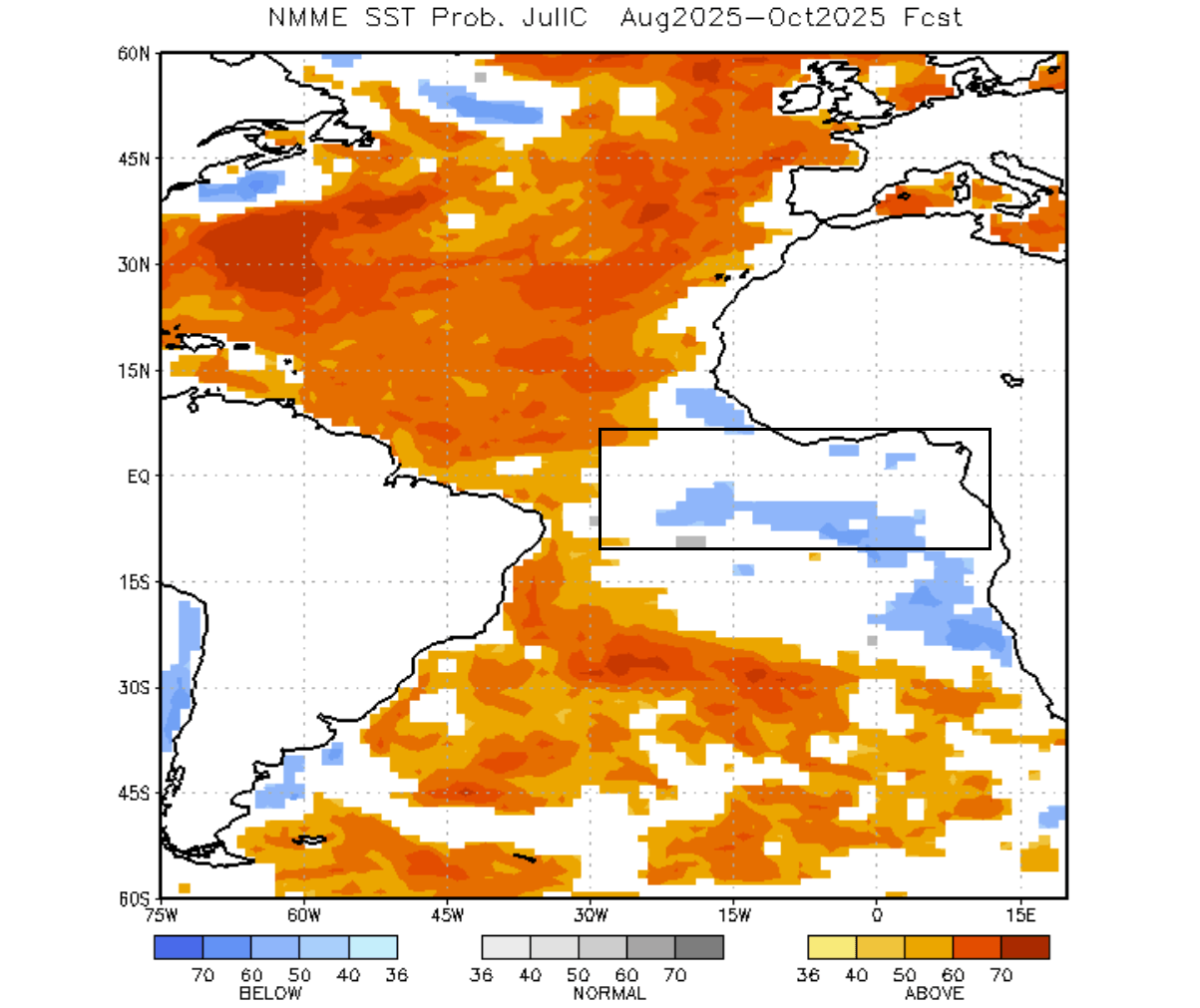
The precipitation forecast from the same model blend shows a drier area directly across the main development region (MDR). This directly indicates a less active hurricane season with below-average numbers, consistent with an Atlantic Niña atmosphere. But an area of more rainfall between Bermuda and the United States does indicate a potential for a few homegrown tropical systems.

Looking at the precipitation forecast from the ECMWF for the same period also shows a broad area of less precipitation over the MDR, as expected. But like the NMMM, this model also shows more rainfall in the Gulf, over the eastern United States, and in the Bermuda area. This also hints at some possible tropical systems growing or intensifying closer to the United States.
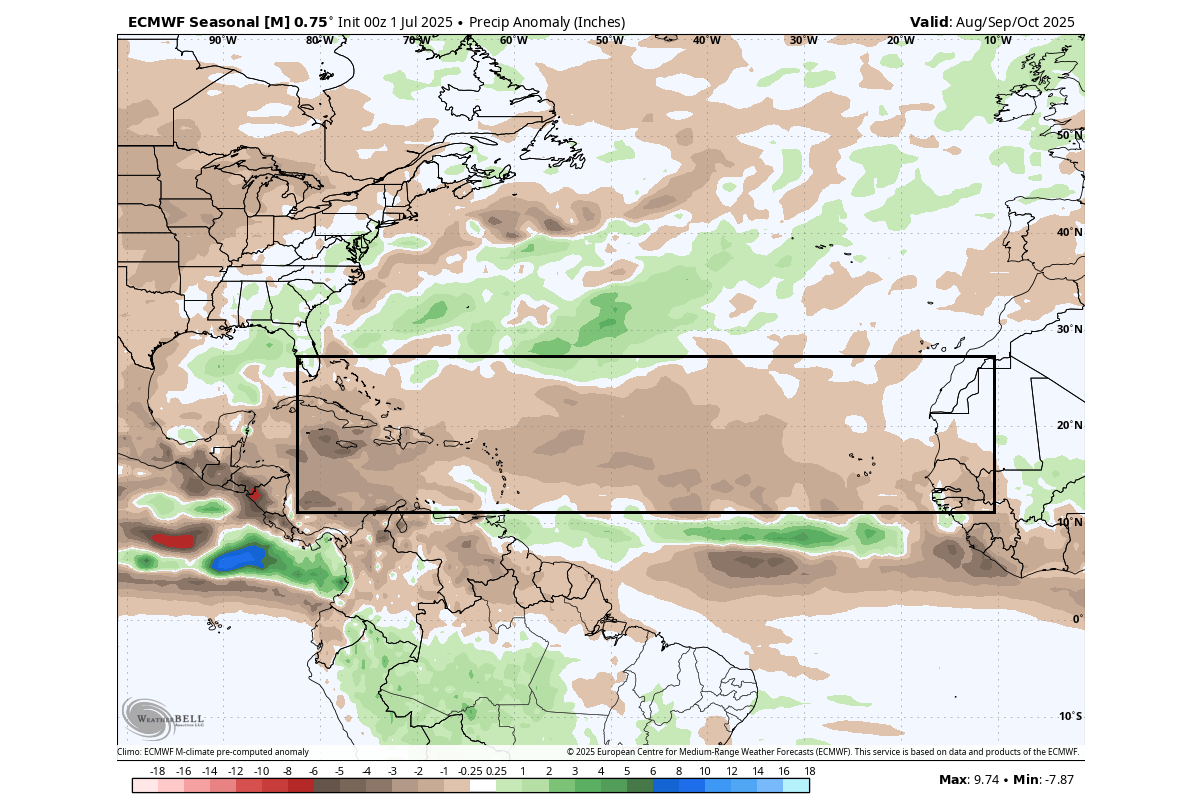
So even if there is a smaller number of total systems, some tropical formation will still occur at some point, and only one is enough. So we will monitor this area closely.
As all these anomalies have a significant impact on the global weather system, we must also consider the seasonal connections with the winter season and what a quiet hurricane season could mean for 2025/2026.
WINTER 2025/2026 CONNECTIONS
We decided to look at the data over the last four decades to find any connection between a quiet hurricane season and the following winter weather. To estimate a hurricane season, NOAA uses the total strength and duration of Atlantic tropical storms and hurricanes. The measure of overall activity used by NOAA is called the Accumulated Cyclone Energy (ACE) index.
Below is the ACE index of the current 2025 season and the long-term average or “climatology” as it’s called. You can see that the current numbers are really low, making this one of the slowest starts of the hurricane season in recent years. We can expect a rise during peak season, but total ACE can overall stay well below normal.
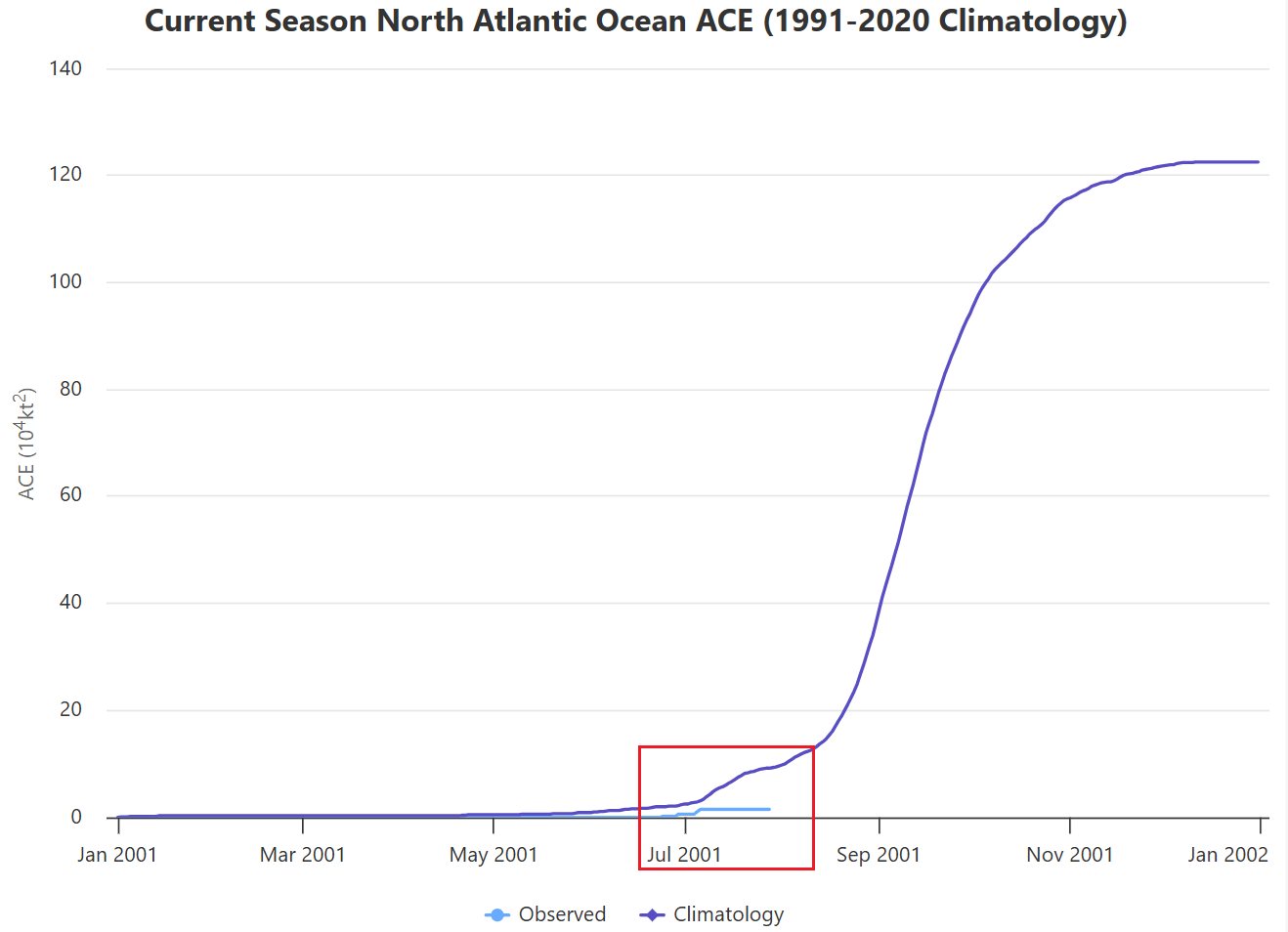
Of course, Winter patterns are not always directly a result of the Atlantic Niña or the hurricane season itself. Both can actually be more of an “indicator” of the atmospheric conditions. So the same global conditions that create an Atlantic Niña or a very quiet hurricane season can also correspond to a specific weather pattern the following Winter.
Below is the temperature pattern for the winters following weak hurricane seasons. You can see a colder-than-normal air mass pooling over the United States. This indicates the presence of a low-pressure system over the U.S. and a high-pressure zone over Canada and Europe.
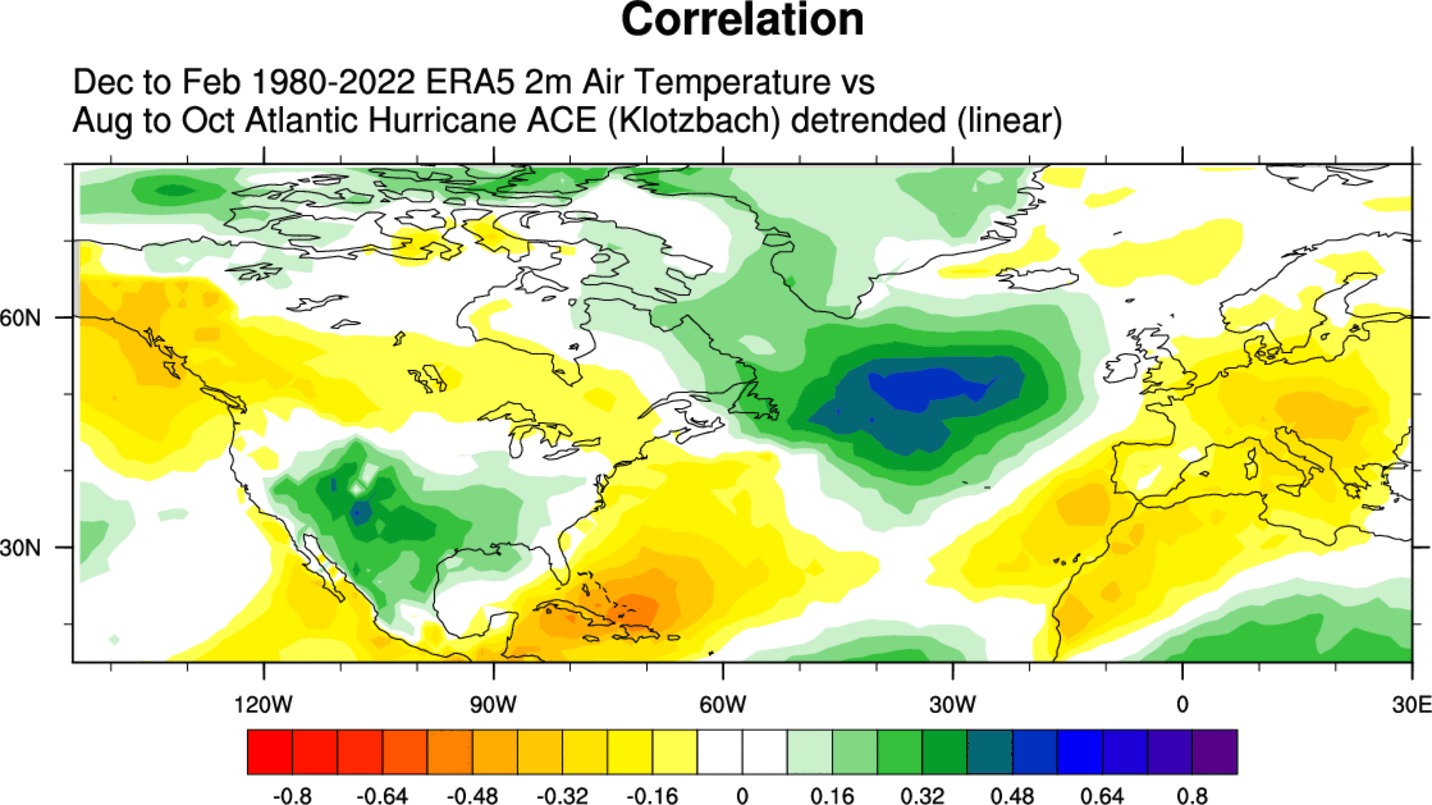
This looks similar to a Pacific El Niño pattern, which is known for creating weaker hurricane seasons, so this analysis likely also shows a connection to an El Niño in the data.
But what we have also found is a connection in the stratosphere. The image below shows a warmer winter stratosphere and a weaker/disrupted Polar Vortex in the stratosphere, following a slow hurricane season. Not to imply that the hurricane season directly impacts the Polar Vortex, but there is likely some common factor at play.
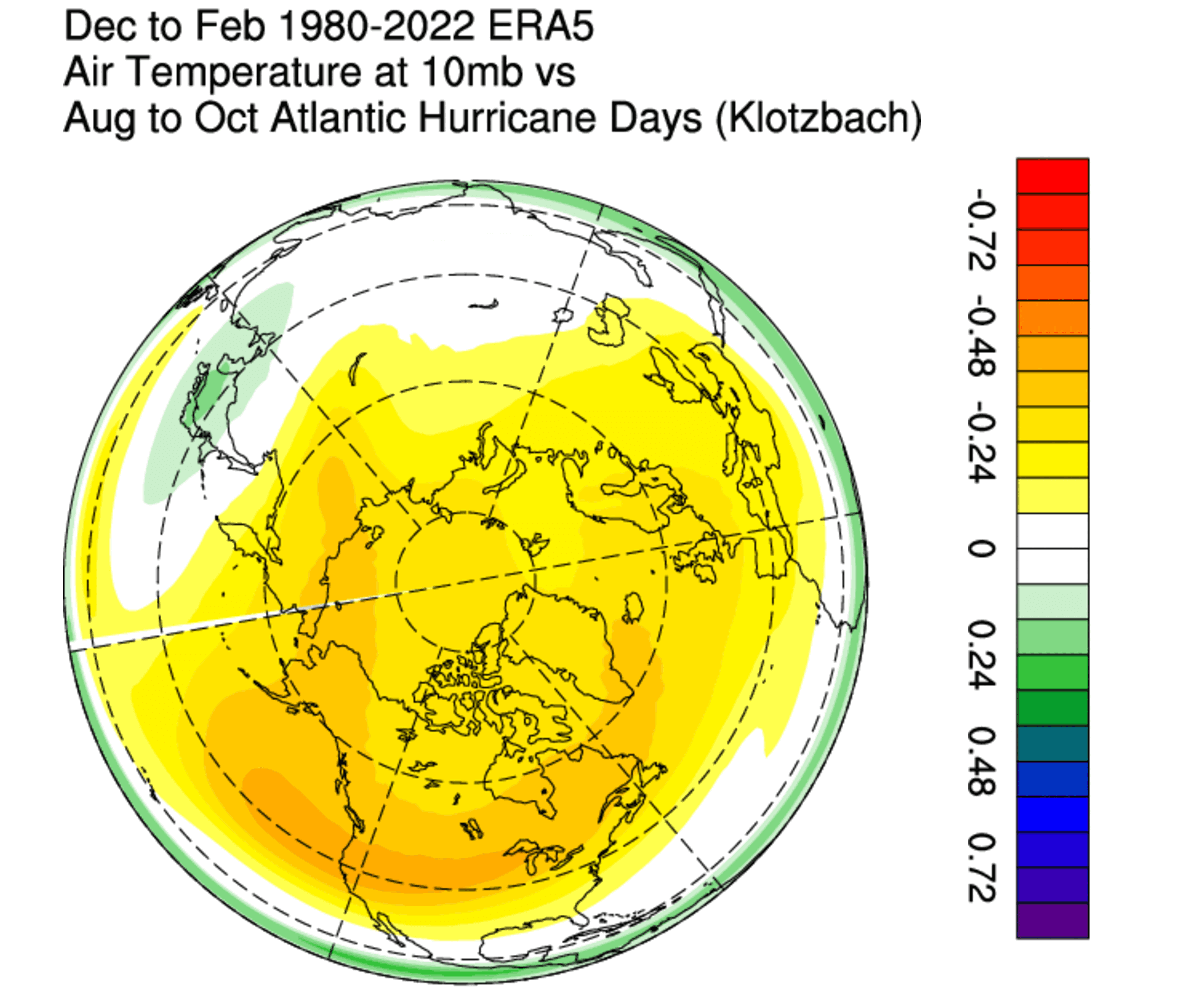
A weak Polar Vortex creates a disrupted jet stream pattern, leading to a strong weather response. As a result, it has a harder time containing the cold air, which can now more freely escape from the polar regions into the United States or other mid-latitude regions.
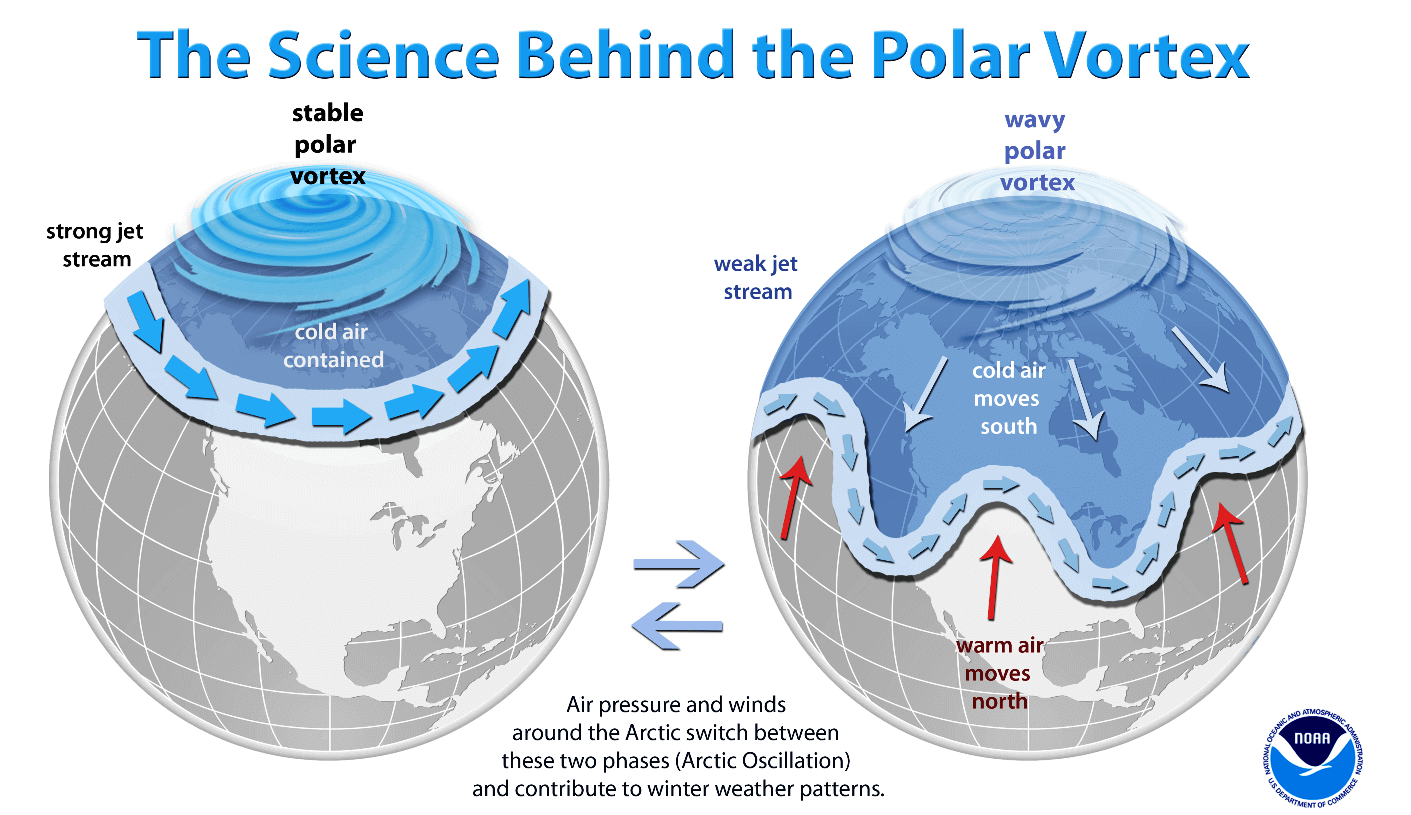
So, if you want a colder and snowier Winter, your best bet is a weak Polar Vortex. In nature, a weak Polar Vortex essentially means a breakdown of the stratospheric Polar Vortex, resulting in the spill-out of cold air from the polar regions.
This is something we will monitor closely over the coming weeks and months, as the peak of the hurricane season approaches. And even low activity can perhaps tell us a lot about the upcoming Winter 2025/2026 weather patterns across the United States, Canada, and the rest of the Northern Hemisphere.
We will keep tracking the latest global weather patterns and forecasts, so be sure to bookmark our page to stay updated. If you found this article in the Google App (Discover), tap the ♥ or star to see more of our weather and nature coverage in your feed.
Don’t miss:
Fall 2025 Forecast: A Major Weather Pattern Reversal Leading Into Winter